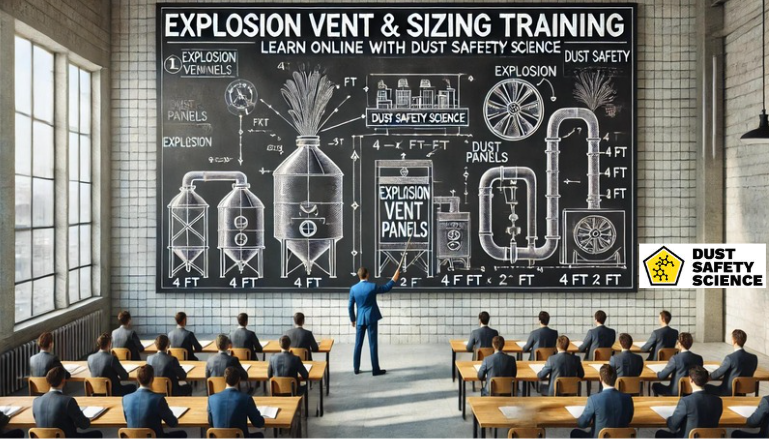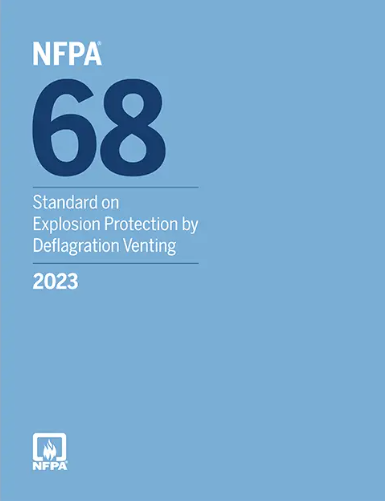Published December 26, 2024 Authored by Dr. Chris Cloney and Jon Barrett of Dust Safety Science

Explosion Vent and Sizing Training: Elevate Your Safety Standards
Did you know that dust explosions cause hundreds of injuries and millions of dollars in damages annually across industries? A dust explosion can escalate in milliseconds, destroying facilities and endangering lives. This hazard and process underscores the critical need for proactive measures to mitigate these risks. For industries handling combustible dust, proper safety training in explosion venting and sizing is essential.
Industries that handle combustible materials, such as food processing, chemical manufacturing, and woodworking, face unique challenges in mitigating dust explosion risks. Dust, when suspended in air under the right conditions can become highly explosive. Mitigating this danger involves a comprehensive approach that includes hazard assessment, housekeeping, and explosion venting systems. However, one of the most complex and misunderstood aspects of explosion safety is explosion vent sizing.
Every year, combustible dust explosions and incidents happen across all manufacturing industries, causing widespread destruction, injuries, and even loss of life. The financial toll is staggering, with billions in property damage and legal costs. Despite the risks, many industrial facilities and manufacturing plants must tackle the challenges of combustible dust.
The question is: Are you doing enough to protect your business and employees? To create a safer workplace, visit Dust Safety Science’s Training Course: Basics of Explosion Vent Sizing using NFPA 68
The Devastating Consequences of Dust Explosions
Combustible dust incidents don’t just cause physical damage—they devastate lives. Workers face injuries or fatalities, businesses lose productivity, and the aftermath often leads to reputational damage and regulatory fines. To address this hidden threat, proactive safety measures are essential. Enter Dust Safety Science’s Training Course: Basics of Explosion Vent Sizing using NFPA 68 a game changer in industrial safety.
Vent Sizing Training: A Necessary Defense
Explosion vent sizing is more than just a technical detail, it’s a life-saving measure. Incorrectly sized vents can fail to relieve pressure effectively, leading to catastrophic structural damage and loss of life. Conversely, oversized vents may unnecessarily increase costs and operational disruptions. This delicate balance makes proper training in explosion vent sizing a cornerstone of industrial safety.
Take the first step toward creating a safer workplace, visit Dust Safety Science’s Training Course: Basics of Explosion Vent Sizing using NFPA 68. The training solutions equip organizations to handle combustible dust risks effectively.
Understanding Explosion Venting
The Basics of Explosion Venting
Explosion venting is a critical safety mechanism designed to relieve pressure during an explosion. When a dust explosion occurs, the rapid combustion generates high-pressure waves that can destroy equipment and structures. Explosion vents act as a controlled weak point, allowing excess pressure and flames to escape safely, minimizing damage.
Factors Influencing Vent Sizing and Location
Proper vent sizing and placement require a detailed understanding of several factors:
- Explosion Severity: The material’s explosivity (measured as KSt values) determines the pressure relief requirements.
- Building Structure: The location and size of vents depend on the facility’s design, including walls, ceilings, and nearby equipment.
- Vent Type: The type of vent—such as panel vents, disk vents, or rupture disks—affects performance and placement considerations.
Types of Explosion Vents
There are several types of explosion vents available, each suited to specific applications:
- Panel Vents: Lightweight panels that open to release pressure.
- Disk Vents: Circular devices ideal for high-pressure applications.
- Rupture Disks: Designed to burst at predetermined pressure levels for reliable protection.
Understanding these types ensures that facilities can select the right solution for their unique needs.
Industries at Risk of Combustible Dust Explosions
While combustible dust hazards exist in many industries, some industries are more prone to combustible dust explosions than others:
- Food Processing: Flour, wheat, sugar, and grain dust.
- Woodworking: Sawdust and fine wood particles.
- Pharmaceuticals: Fine powders, plastics, and chemicals.
- Biomass: Wood, wood residues, energy crops, agricultural residues including straw, peat, and organic waste from industry and households.
- Coal: Coal dust and Coking coal dust
- Metalworking: Aluminum, magnesium, zirconium, and other metallic dust.
Each industry requires customized training to manage unique risks. Learn how tailored training can address these challenges by visiting Dust Safety Science’s Training Page.
Why Explosion Vent Sizing Training Safety Training is Crucial
Regulatory Compliance
Regulatory agencies like the Occupational Safety and Health Administration, OSHA, and standards like the National Fire Protection Association, NFPA 68, mandate measures to control combustible dust risks and explosion protection by deflagration venting. Failure to comply not only endangers lives but also leads to penalties. Training helps organizations stay compliant and avoid legal consequences.
In addition, NFPA 68, Standard on Explosion Protection by Deflagration Venting, applies to the design, location, installation, maintenance, and use of devices and systems that vent the combustion gases and pressures resulting from a deflagration within an enclosure so that structural and mechanical damage is minimized.
Risk Mitigation
Identifying and mitigating dust hazards is central to a safe work environment. Training programs, such as those offered by Dust Safety Science, provide actionable insights to reduce risks through Dust Hazard Analyses (DHA) and preventive strategies.
Employee Safety
Education is key to empowering workers. Through training, employees learn to:
- Recognize Combustible Dust Hazards.
- Use properly rated, Explosion Vents, Combustible Dust Control Equipment, such as Dust Collectors, Dust Control Fans, and Combustible Dust rated Vacuums.
- Use personal protective equipment (PPE) effectively.
- Follow emergency procedures during incidents.
Operational Efficiency
Preventing explosions reduces downtime, maintains productivity, and saves costs associated with accidents. Proper training ensures smoother operations and a safer workplace.
Why Choose Dust Safety Science for Explosion Vent and Sizing Training?
Comprehensive Curriculum
The Dust Safety Science’s Training Course: Basics of Explosion Vent Sizing using NFPA 68 covers the essentials of explosion venting and vent sizing, including:
- Fundamentals of explosion venting mechanisms.
- Detailed vent sizing calculations based on material properties and facility design.
- Best practices for vent selection and maintenance.
This comprehensive curriculum provides a solid foundation for professionals across industries.
Expert Instructors
With a team of seasoned professionals, Dust Safety Science brings unparalleled expertise. Their instructors ensure participants receive actionable, industry-specific guidance.
Flexible Training Options
Choose a format that fits your needs:
- Online Courses: Flexible and accessible.
- In-Person Training: Hands-on experience for practical learning.
- Hybrid Options: A blend of convenience and interactivity
Customized Training Solutions
Every industry faces unique challenges. Dust Safety Science offers tailored training solutions, that address specific risks and compliance needs. Start customizing your training today by visiting Dust Safety Science’s Training Course: Basics of Explosion Vent Sizing using NFPA 68
Take Action: Ensure Your Facility’s Safety Today
Combustible dust is an invisible threat with potentially devastating consequences. Comprehensive safety training is not optional—it’s a necessity. Protect your workforce, reduce risks, and ensure regulatory compliance by investing in professional training.
Start your journey toward a safer workplace today by enrolling in Dust Safety Science’s Training Course: Basics of Explosion Vent Sizing using NFPA 68. Learn more about their programs and how they can benefit your organization.
Don’t wait until it’s too late. Visit Dust Safety Science’s Training Course: Basics of Explosion Vent Sizing using NFPA 68 now to secure your facility’s future.

About Dust Safety Science
Dr. Chris Cloney, of Dust Safety Science, provides additional information on Explosion Venting and Combustible dust explosion training, with a Podcast. Click on the latest Podcast Links: Combustible Dust Explosion Prevention and Protection and Case Study – Insufficient Venting During Sawdust Silo Explosion Leads to Fatality and Challenges Using Rule Of Thumb Method For Explosion Venting Requirements

Resources:
Visit: Dust Safety Science’s Training Course: Basics of Explosion Vent Sizing using NFPA 68
Visit Latin America Dust Explosion Safety and Dust Hazard Analysis Demystified Online Training
Visit: Dust Safety Science’s Training Page
Visit: Fire and Explosion Protection Equipment Providers
Visit: Risk Assessment & Dust Hazard Analysis Providers
Visit: Combustible Dust Testing Providers
Visit Dust Safety Science (Global Incident Tracking)
Visit Dust Safety Academy (Resources, Training, and Events)
Visit Dust Safety Professionals (Need Help? Get Support Today!)
Visit Dust Safety Journal for the Dust Safety Science Monthly Journal
Subscribe to our FREE, Dust Safety Science Newsletter at Dust Safety Science Newsletter
Visit the Dust Safety Science blog for written articles on combustible dust safety including the latest research, expert opinions, and state-of-the art in fire and explosion protection.
